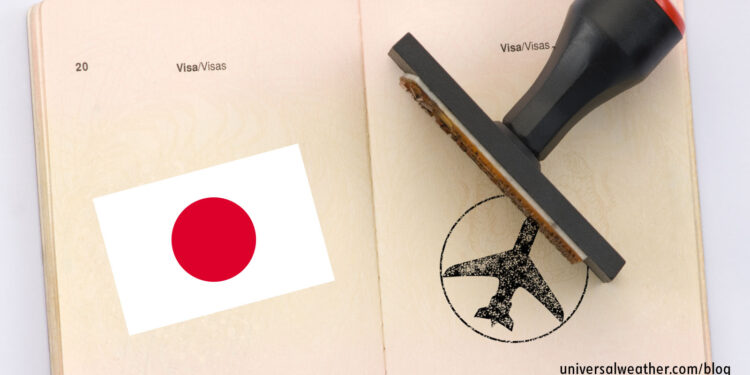Business Aviation Trip Planning Tips: Operating to Japan – Customs, Immigration, and Quarantine

This is a post by author Hiroshi Higashiyama. Hiroshi is representative director for Universal Aviation Japan, which has aircraft ground handling facilities in Haneda, Narita, Sapporo, and Osaka. Hiroshi is an expert on business aircraft operations in Japan and can be contacted at hiroshihigashiyama@universalaviation.aero.
This aviation blog post is part of a series on operating to Japan and continues from our last article entitled “Business Aviation Trip Planning Tips: Operating to Japan – Ground Handling.”
Customs, Immigration, and Quarantine (CIQ) is an easy process assuming correct documentation is provided. For business aircraft operators traveling to Japan, best practice is to work with your 3rd-party provider and ground handler in advance to confirm all documentation and visa requirements.
The following is an overview of what you need to know:
1. Crew do not require visas
Crew, regardless of nationality, receive “shore passes” for operations into Japan. Your ground handler will need information, in advance, to make these arrangements and avoid delays on arrival. Shore passes are available to all crew, including flight attendants and aviation maintenance technicians, indicated on the general declaration (gen dec). Passes can even be set up for crew swaps – where crew members arrive or depart via commercial airlines – so long as crew are listed on the gen dec.
2. Passengers and crew normally clear CIQ in the main terminal
You’ll normally clear CIQ within the main terminal, with some exceptions:
- Kobe (RJBE) has a Fixed-Base Operator where passengers/crew can clear CIQ.
- Narita (RJAA) has a dedicated general aviation terminal. Note that a charge applies for use.
3. Know CIQ clearing procedures
Your ground handler will transport crew/passengers/luggage through CIQ at the main terminal. At most larger airports, crew and passengers will clear CIQ separately. Your ground handler will fill out arrival/departure cards, provided the information has been received in advance. CIQ clearance usually takes about 10 minutes, depending on the terminal, and crew/passengers often must wait in line with commercial passengers. At larger airports – including Haneda (RJTT) – there’s a separate CIQ line for crew. There’s no charge for CIQ clearance, but a passenger tax is collected at some airports. Your ground handler normally settles this for you, and payment is made at a later time.
4. Consider all documentation requirements
All crew and passengers must have passports with validity through their entire stay in Japan. Certain passengers require visas for Japan (for more information http://www.mofa.go.jp/j_info/visit/index.html), and visas must be obtained prior to arrival. Passengers arriving without visas may be immediately deported or, at discretion of immigration officer on duty, allowed entry. If a stop in Japan is for purposes of crew rest only, passengers without visas may be able to obtain shore passes. Shore passes obtained by crew are normally only valid for up to eight days for a single stop in Japan. In some cases, shore passes can be arranged for up to 15 days to cover multiple airport operations.
5. Do not plan to clear CIQ onboard your aircraft
Only RJBE permits customs clearance on board. Official lead time to set this up is 14 days, but permission may be approved with less notice at the discretion of airport authorities. It’s possible to clear CIQ on board for medical emergency flights anywhere in Japan, but only the patient and medical team will be cleared onboard. Crew need to clear CIQ at the terminal.
6. You’ll be restricted in terms of what you can offload in Japan
Plant material and most animal products are restricted in Japan. There may be exceptions if a product is stamped for export. Most in-flight catering may be offloaded and stored at the airport in certain cases, but that depends on the airport and types of food involved. It’s best to check with your ground handler on what is and is not permitted into Japan.
Guns are highly restricted and prohibited. If crew and passengers have weapons, the ground handler will need to notify airport police, in advance, and arrange safe keeping. If guns are offloaded without notification, this can result in the passenger or crew member being arrested, deported, and not permitted back into the country.
Bringing pets to Japan can also be problematic. A letter from a vet must be obtained, vaccinations must be up to date, and you must bring any pet medications for 90 days. The animal will be quarantined for up to 90 days until your ground handler obtains permission for its release.
For more information, review the following:
- Plants: http://www.pps.go.jp/english/index.html
- Animal products: http://www.maff.go.jp/aqs/english/product/import.html
- Customs: http://www.customs.go.jp/english/exp-imp/index.htm
Conclusion
Although CIQ clearance in Japan is usually via the main terminal, your ground handler will assist, and things usually go quickly. Crew shore passes require some advance coordination with your ground handler, but this is a smooth and easy process. Worst-case scenario, when operating to Japan, would be to land with undeclared guns and a non-confirmed pet that may be whisked straight off into quarantine.
Questions?
If you have any questions about this article or operating to Japan, contact me at hiroshihigashiyama@universalaviation.aero.
Later we will discuss fuel, security, and additional services for your trip to Japan.




